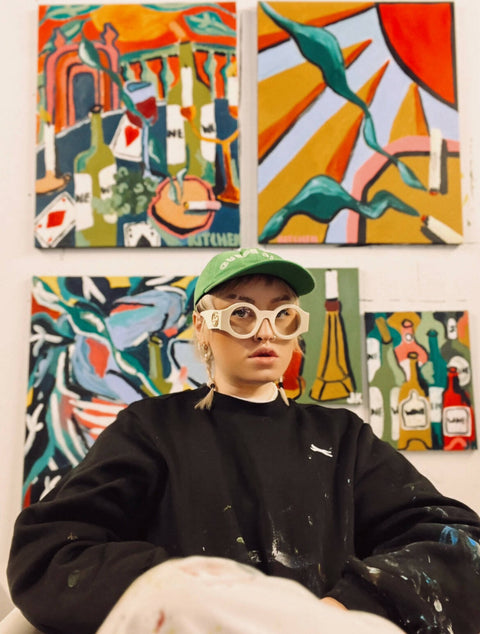
SOTA Sessions Vol 1: Jo Kitchen
Introducing SOTA Sessions, our new feature where we speak to artists, designers and tastemakers about all things creative. Our aim, to inspire and introduce you to new techniques, tips and add some magic to your day. Because we all need some vibes right now!
Volume 1: Jo Kitchen.
Tell us about your latest works, ‘Cig Break’.
Cig Break is a series of six small works, consisting of just a packet of cigarettes and a lighter. I like the contradiction of a cig break being a moment to step outside and take a minute for yourself whilst simultaneously being quite a destructive or unhealthy habit for yourself to have.
I also enjoy how the simplicity of two objects — a packet of cigarettes and a lighter can get you out of a lot of situations. Need a break from work — cig break. Need to get out of a boring conversation at a social event - go for a cig. Find yourself in an awkward situation - go outside for a cigarette. I enjoy the humour in nobody being able to question the act of that.
How do the words ‘romance’ and ‘memory’ apply to your art-making process?
The majority of my work is thought up through hyper-romanticising moments or personal experiences. Overly romanticising these points in time that may have not been that significant or that great in the moment and recreating those memories, through often abstracted versions of those events. A lot of my practice focuses on zooming in on tiny aspects of those memories, whether that be a discarded cigarette butt, the aftermath of a dinner party or a burnt-out candle. The things that I paint are a tiny snippet of the bigger picture or memory that I hone in on and obsess over.
Do you see yourself as a chronicler of the ‘real’ or the appropriated image mixed with the swelling memory — you call it a ‘haze’, but how much of your art is autobiographical, and how much is fiction?
For me, it can only be a mix of both. I think when you look back on a memory or a time or place the reality of that memory automatically becomes abstracted — whether that be visually or emotionally, it differs from the truth of that specific moment. I think naturally, in storytelling, parts of the portrayal of that story become compromised. For me, in the sense of painting, that happens through changing elements of that memory, to make the composition work or for colours to merge better with one another. This automatically transports the painting to this in-between point between being autobiographical and fictional.
How important is scale in your own practice?
I don’t consider it to be a massive part of my practice. I think scale for me just enhances the element of play involved when creating it. I think both small and large works can both have a big impact in artworks, so I try to play around with both.
In your art-making process, particularly in your use of collage, colour, and scale, what comes first: re-appropriating your own experience, or, responding to something that stops you in the moment?
I rarely respond to things that stop me in the moment, even when I’m drawing or painting from still life or landscapes I tend to only look at what it is I'm painting once or twice. I think it's important for my work to have that level of realism removed and recreate my own versions, or experiences of those things - It allows me to stop over analysing the tiny details and be more creative with it. I incorporated collage into my paintings very early on as this helps me be less precious about what it is I’m painting and allows me to instinctively cut, stick and paint which then becomes more than the physical thing and leans more into a freer expression of what it is I’m painting.
You use the phrase, ‘hyper-idealised hindsight’, what does this mean for your work?
The majority of my work is funnelled through this over-romanticising of a specific place or time. I think a lot of people tend to think back to points in their lives with this idea that it was better than the reality of what it actually was. I enjoy the way memory in both visceral and physical senses tends to become abstracted in your mind and how for me that then translates onto the canvas through shape, form and colour.
In your view, what advice is important for artists and creatives to bring more creativity into their lives?
I think viewing a lot of art is important. Whenever I’m feeling uninspired, visiting galleries and consuming a lot of art in person is super important for me to break out of that.
Another thing that I find important in bringing about my own creativity is allowing yourself to play and have fun with ideas. Ridding yourself of the idea that the work you create needs to be ‘good’ in order for it to be created. I think whenever you have an idea you just need to do it and not overthink it, I think overthinking an idea or project is detrimental to the creation of work.
***
Take a look at Jo's full profile here!
